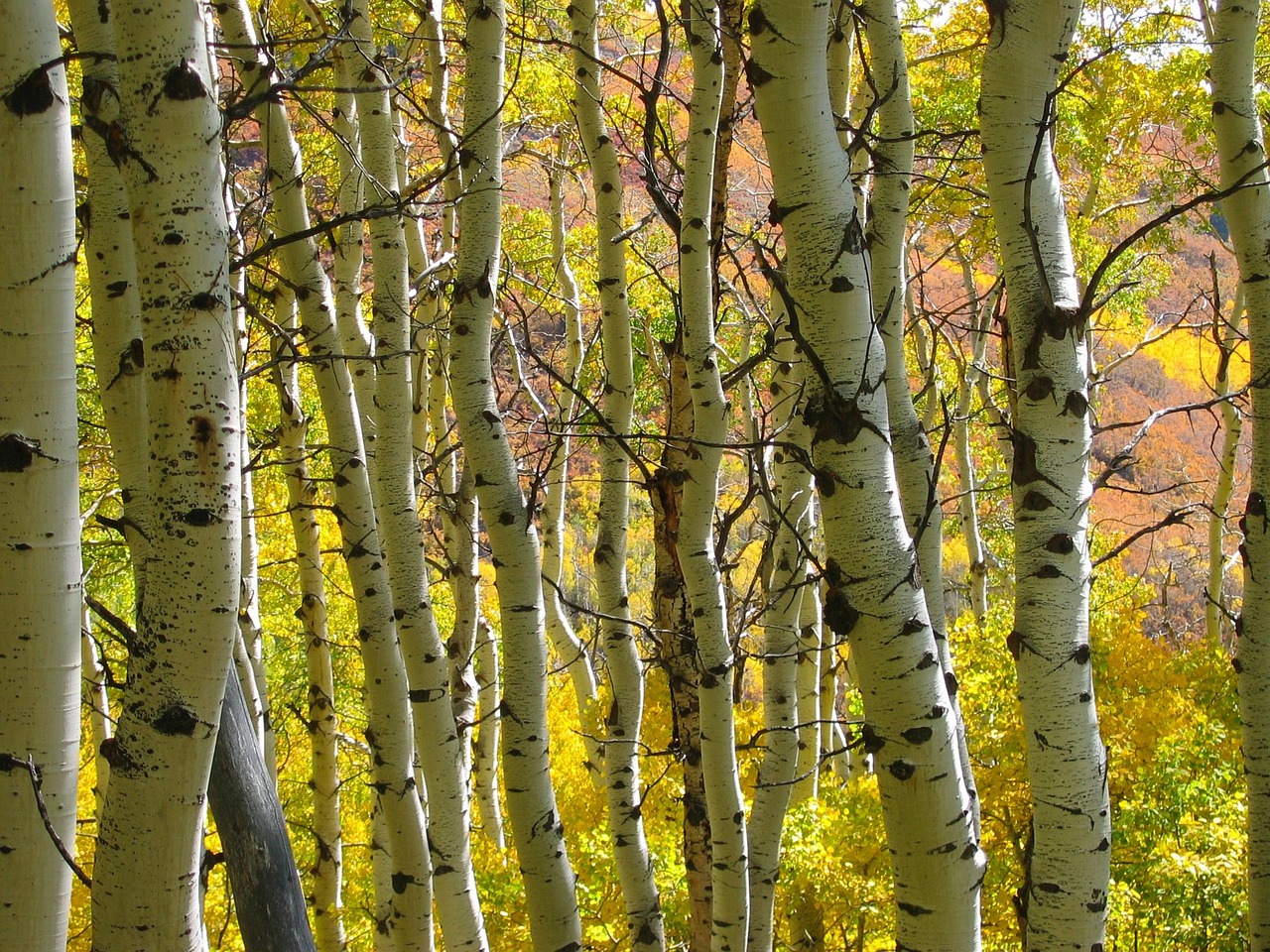Quaking aspens are not considered an invasive species. They are native to North America and grow in diverse environments. However, their ability to spread rapidly can sometimes lead to dense stands that may outcompete other species in certain areas.
Understanding Quaking Aspens

Quaking aspens, scientifically known as Populus tremuloides, are a popular tree species found throughout North America. They are renowned for their distinct white bark and shimmering leaves that flutter in the wind, creating a picturesque landscape. These trees typically thrive in cooler climates and are often seen in mountainous regions, mixed forests, and along riverbanks.
Quaking aspens are unique among trees due to their remarkable ability to reproduce. They can propagate both through seeds and vegetatively by sending up shoots from their root systems. This vegetative reproduction is what can lead to their rapid spread in certain areas, often forming large clonal groves. While this is a natural process, it raises questions about their impact on local ecosystems.
Characteristics of Quaking Aspens
There are several notable characteristics of quaking aspens that make them distinct:
- Leaves: The leaves are round and have a flat petiole, allowing them to tremble or “quake” in the breeze.
- Bark: The bark is smooth and light-colored, often described as white or pale yellow-green.
- Growth Habit: These trees can grow up to 50 feet tall and have a slender, straight trunk.
- Flowers: Quaking aspens produce catkins, which are cylindrical flower clusters that bloom in early spring.
Habitat and Distribution
Quaking aspens are commonly found across a wide range of habitats. They prefer well-drained soils and can grow in both sunny and partially shaded areas. Their distribution spans from Canada down through the United States, reaching as far south as New Mexico. The following table illustrates their typical habitats:
| Region | Typical Habitat |
|---|---|
| Canada | Forests and wooded areas, particularly in the northern regions. |
| United States | Mountainous regions, mixed forests, and along water bodies. |
| Mexico | High elevations with suitable moisture levels. |
Ecological Role
The ecological role of quaking aspens is significant. They provide habitat and food for various wildlife species. Birds, mammals, and insects benefit from the shelter and sustenance these trees offer. Furthermore, aspens play a crucial role in maintaining soil health by preventing erosion and promoting nutrient cycling.
However, their ability to spread aggressively can sometimes create challenges for other native species. In some regions, dense stands of quaking aspens can outcompete understory plants for sunlight and resources. This dynamic prompts discussions among ecologists about the balance between their beneficial aspects and their potential to dominate local ecosystems.
In summary, quaking aspens are valued for their beauty and ecological contributions. While they are not invasive by definition, their growth patterns can lead to challenges in specific environments. Understanding their nature helps in managing landscapes where they thrive.
Potential Challenges Posed by Quaking Aspens
While quaking aspens are not classified as invasive species, their rapid growth and ability to form extensive clonal groves can lead to certain challenges in forest ecosystems. Understanding these challenges is essential for effective forest management and conservation efforts.
Competition with Native Species
One of the primary concerns regarding quaking aspens is their potential to outcompete native plant species. When a stand of aspens becomes established, it can limit the growth of other trees and understory plants. This competition occurs due to several factors:
- Shade Tolerance: Quaking aspens produce a dense canopy that can shade out smaller plants, inhibiting their growth.
- Resource Consumption: Aspens require significant amounts of water and nutrients, which can limit availability for other species.
- Root Competition: Their extensive root systems can monopolize soil resources, further disadvantaging other plants.
Impact on Biodiversity
The dominance of quaking aspens in certain areas may lead to reduced biodiversity. When a single species becomes overly dominant, it can disrupt the balance of the ecosystem. This can result in:
- Decline in Plant Diversity: Fewer species may be able to thrive in areas where quaking aspens dominate.
- Altered Animal Habitats: Changes in plant diversity can affect the animal species that rely on those plants for food and shelter.
- Pest and Disease Vulnerability: Monocultures, where one species dominates, can be more susceptible to pests and diseases.
Management Strategies
To address the challenges posed by quaking aspens, various management strategies can be employed. These strategies aim to balance the benefits of aspen trees with the need to preserve diversity in forest ecosystems:
- Selective Thinning: Removing some aspen trees can reduce competition and allow other species to thrive.
- Controlled Burns: Prescribed fire can help maintain healthy ecosystems by reducing aspen dominance and encouraging the growth of diverse plant species.
- Monitoring and Assessment: Regular monitoring of forest health can help identify areas where quaking aspens may be becoming too dominant.
The Role of Quaking Aspens in Climate Resilience
Despite the potential challenges associated with quaking aspens, they play a vital role in climate resilience. Their ability to adapt to changing environmental conditions makes them a valuable species for forest ecosystems.
Carbon Sequestration
Quaking aspens contribute significantly to carbon sequestration. They absorb carbon dioxide from the atmosphere and store it in their biomass. This process helps mitigate climate change effects by reducing greenhouse gas concentrations. Key factors include:
- Fast Growth Rate: Aspens grow quickly, allowing them to capture more carbon over shorter periods.
- Healthy Forest Ecosystems: Diverse forests with healthy aspen populations tend to sequester more carbon overall.
Erosion Control and Soil Health
The extensive root systems of quaking aspens play a crucial role in preventing soil erosion. Their roots stabilize the soil, particularly on slopes and near water bodies. Additionally, these trees contribute organic matter to the soil, enhancing its health and fertility.
This improvement in soil quality supports a wider range of plant species, further promoting ecosystem diversity. Thus, while quaking aspens can pose challenges in some contexts, they also provide essential benefits that support overall ecosystem health.
Quaking Aspens and Their Cultural Significance
Quaking aspens hold a special place not only in ecological systems but also in cultural contexts. They are often associated with various traditions and values among indigenous peoples and communities across North America.

Indigenous Uses of Quaking Aspens
Many indigenous tribes have utilized quaking aspens for various purposes, showcasing their versatility. The following are some traditional uses:
- Medicinal Applications: Various parts of the aspen tree, including bark and leaves, have been used to create herbal remedies. These remedies were traditionally used to treat ailments such as fevers and infections.
- Crafting Materials: The flexible branches of quaking aspens were often used in crafting tools, baskets, and other items essential for daily life.
- Symbolic Significance: In many cultures, aspens are seen as symbols of strength and resilience, representing the interconnectedness of life.
Quaking Aspens in Folklore and Art
Beyond practical uses, quaking aspens have inspired folklore, stories, and art. Their unique appearance and behavior have made them subjects of admiration and symbolism:
- Folklore: Many Native American myths reference quaking aspens, often portraying them as guardians of the forest or messengers between the earthly and spiritual realms.
- Artistic Inspiration: The striking beauty of quaking aspens has made them a popular subject for artists and photographers, symbolizing nature’s beauty and tranquility.
Quaking Aspens in Modern Landscapes

In contemporary settings, quaking aspens continue to play an important role in urban landscaping and reforestation efforts. Their adaptability makes them a favored choice for various landscapes.
Urban Landscaping
Quaking aspens are increasingly used in urban environments due to their aesthetic appeal and environmental benefits. Some reasons for their popularity include:
- Aesthetic Value: The vibrant fall colors of aspen leaves, ranging from bright yellow to golden hues, enhance the visual appeal of urban parks and gardens.
- Shade Provision: As they grow tall, these trees provide shade, helping to cool urban areas and improve the quality of life for residents.
- Wildlife Habitat: Urban areas that incorporate quaking aspens can support local wildlife populations, including birds and insects.
Reforestation and Restoration Projects
Quaking aspens are also vital in reforestation efforts. Their ability to establish quickly and thrive in various conditions makes them ideal candidates for restoration projects. Key benefits include:
- Soil Stabilization: Their root systems help stabilize soils, which is crucial in preventing erosion on disturbed lands.
- Diversity Promotion: Incorporating quaking aspens into reforestation projects encourages the growth of diverse plant communities, enhancing ecosystem resilience.
- Wildlife Support: Restored areas with aspen groves can provide essential habitat for various species, contributing to biodiversity recovery.
Climate Change Adaptation
The ability of quaking aspens to adapt to changing climate conditions further highlights their importance in forest ecosystems. As climate change continues to impact forests worldwide, understanding how these trees cope with shifts is crucial.
Drought Resistance
Although quaking aspens prefer moist environments, they have shown some capacity to withstand periods of drought. Factors contributing to their resilience include:
- Deep Root Systems: Their roots can extend deep into the soil, allowing them access to moisture during dry spells.
- Clonal Growth: The ability to produce new shoots from extensive root systems enables them to maintain populations even when individual trees face stress.
Pest and Disease Resistance
Quaking aspens have developed some natural defenses against pests and diseases. However, they can still be vulnerable to specific threats. Understanding these vulnerabilities is key to managing their health:
- Natural Defenses: Chemical compounds in aspen bark can deter certain herbivores, helping protect the trees.
- Pest Management: Monitoring for pest infestations, such as the forest tent caterpillar or aspen borers, is essential for maintaining healthy aspen populations.
This combination of resilience and vulnerability underscores the need for ongoing research and adaptive management strategies to ensure the continued health of quaking aspens in changing environments.
Future Research and Conservation Efforts
The ongoing study of quaking aspens is essential, particularly as environmental changes continue to impact their habitats. Researchers and conservationists are focusing on several areas to ensure the sustainability of these iconic trees.
Genetic Studies
Understanding the genetic diversity of quaking aspens is crucial for their conservation. Genetic studies can provide insights into:
- Adaptation Potential: By analyzing genetic variations, scientists can determine how different populations may adapt to changing climates.
- Resilience Against Diseases: Identifying genetic traits that confer resistance to pests and diseases can inform breeding programs aimed at enhancing tree health.
Habitat Restoration Projects
Efforts to restore habitats where quaking aspens are native are vital for maintaining biodiversity. Restoration projects may include:
- Replanting Initiatives: Planting young aspen trees in areas where they have declined can help re-establish populations and ecosystems.
- Monitoring Ecosystem Health: Regular assessments of aspen groves and associated wildlife populations will help gauge the effectiveness of restoration efforts.
- Community Involvement: Engaging local communities in restoration projects fosters a sense of stewardship and increases public awareness of the importance of these trees.
Quaking Aspens and Climate Change Mitigation

As we confront the realities of climate change, quaking aspens can play a pivotal role in mitigation strategies. Their ability to sequester carbon and adapt to varying conditions positions them as valuable allies in efforts to combat climate change.
Carbon Offset Programs
Integrating quaking aspens into carbon offset programs can enhance their contributions to climate goals. These programs may include:
- Reforestation Projects: Planting aspens in deforested or degraded areas can help capture carbon while restoring ecological balance.
- Urban Forestry Initiatives: Incorporating aspen trees into urban planning can contribute to carbon sequestration while improving air quality.
Education and Public Awareness
Increasing public knowledge about the benefits and challenges of quaking aspens is essential for their conservation. Educational programs may focus on:
- Workshops and Seminars: Hosting events that inform people about the ecological roles and cultural significance of quaking aspens can foster interest and stewardship.
- School Programs: Integrating lessons about quaking aspens into school curricula can inspire the next generation to appreciate and protect these trees.
Conclusion
Quaking aspens are not only beautiful and iconic trees; they are integral to the health of many forest ecosystems. Their ability to adapt to various environmental conditions, provide habitat for wildlife, and contribute to climate resilience makes them invaluable. While they present certain challenges, especially regarding competition with other species, their benefits far outweigh these concerns in many contexts.
Ongoing research, conservation efforts, and public education are critical to ensuring the future of quaking aspens. By understanding their ecological roles and promoting sustainable practices, we can preserve these magnificent trees for future generations. In doing so, we not only celebrate their beauty but also recognize their significant contributions to our environment and cultural heritage.
As we look forward, fostering a deeper connection between communities and nature will be essential in safeguarding the legacy of quaking aspens. With continued effort, these trees will thrive, enhancing landscapes and contributing positively to biodiversity and climate health.
